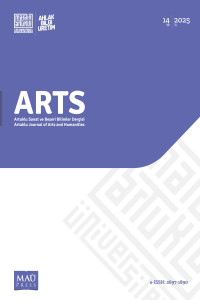Abstract
This study examines Pier Paolo Pasolini’s 1961 film Accattone as an intersection of social criticism, aesthetic strategy, and existential questioning. Using qualitative research methods and narrative analysis, it investigates how themes such as poverty, exclusion, moral decay, and sanctity are conveyed through the portrayal of the protagonist -a marginalized individual residing in the slums of post-war Rome. Pasolini distances himself ideologically from Italian Neorealism, developing a unique cinematic language characterized by expressive visuals, static compositions, and anti-heroic characterisation. This approach offers an alternative ethical and aesthetic vision that challenges established ideological structures. The analysis concludes that Accattone functions as both an artistic expression and a form of political intervention.
References
- Bordwell, D. ve Thompson, K. (2020). Film art: An introduction (12. baskı). McGraw-Hill Education.
- Caminati, L. (2019). Filming decolonization: Pasolini’s geopolitical afterlife. P. G. Cestaro (Ed.), Pier Paolo Pasolini, framed and unframed: A thinker for the twenty-first century (1. baskı). (s. 63-77). Bloomsbury.
- D’Alfonso, A. (2015). Accattone: A new life. Pier Paolo Pasolini, 1961. Oltreoceano, 10, 89-99. https://riviste.lineaedizioni.it/index.php/oltreoceano/article/view/188
- Greene, N. (2017). Pier Paolo Pasolini: Cinema as heresy (1. baskı). Princeton University.
- Kovács, A. B. (2010). Modernizmi seyretmek: Avrupa sanat sineması, 1950-1980 (Çev. E. Yılmaz) (1. baskı). De Ki.
- Nelis, J. (2007). Constructing fascist identity: Benito Mussolini and the myth of Romanità. Classical World, 100(4), 391-415. https://www.jstor.org/stable/25434050
- Ng, P. S. (2007). Poetry of squalor: Exploring the Borgata in Pier Paolo Pasolini’s Accattone. Opticon1826, 2(1), 1-9. https://doi.org/10.5334/opt.020706
- Nowell-Smith, G. (2008). Dünya sinema tarihi (1. baskı) (Çev. A. Fethi). Kabalcı.
- Orr, C. (1995). Pasolini’s Accattone, or naturalism and its discontents. Film criticism, 19(3), 54-66. https://www.jstor.org/stable/44075822
- Pasolini, P. P. (1992). Hepimiz tehlikedeyiz (1. baskı) (Çev. A. Aydın, İ. Kiras, B. Bilgiç Parlak, B. Onaran, T. Ortaç ve E. Bakla). Şehir.
- Pasolini, P. P. (Yönetmen). (1960). Accattone [Film]. Arco.
- Pasolini, P. P. (Yönetmen). (1967). Edipo re [Film]. Arco.
- Pasolini, P. P. (Yönetmen). (1969). Porcile [Film]. Arco.
- Pasolini, P. P. (Yönetmen). (1970). Medea [Film]. Arco.
- Pezzella, M. (2006). Sinemada estetik (1. baskı) (Çev. F. Demir).Dost.
- Puckett, K. (2016). Narrative theory: A critical introduction (1. baskı). Polity.
- Rhodes, J. D. (2004). Scandalous desecration: Accattone against the neorealist city. Framework: The journal of cinema and media, 45(1), 7-33. https://www.jstor.org/stable/41552392
- Rohdie, S. (1995). The passion of Pier Paolo Pasolini (1. baskı). Indiana University.
- Ryan, M. ve Lenos, M. (2012). An introduction to film analysis: Technique and meaning in narrative film (1. baskı). Routledge.
- Thompson, K. ve Bordwell, D. (2019). Film history: An introduction (4. baskı). McGraw-Hill.
- Viano, M. (1993). A certain realism: Making use of Pasolini’s film theory and practice (1. baskı). University of California.
Abstract
Bu çalışma, Pier Paolo Pasolini’nin Accattone (1961) filmini toplumsal eleştiri, estetik strateji ve varoluşsal sorgulamanın kesiştiği bir alan olarak inceler. Nitel araştırma yöntemi ve anlatı analizi kullanılarak, filmde yoksulluk, dışlanma, ahlaki çöküş ve kutsallık gibi temaların, başkarakter olan ve savaş sonrası Roma’nın kenar mahallelerinde yaşayan marjinal bir figür olarak tasviri aracılığıyla nasıl ele alındığı araştırılır. Pasolini, İtalyan Neorealizminden ideolojik olarak uzaklaşır ve ifadeci görsellikler, durağan kompozisyonlar ve anti-kahraman karakterizasyonuyla ayırt edilen özgün bir sinemasal dil geliştirir. Bu yaklaşım, egemen ideolojik yapıları sorgulayan alternatif bir etik ve estetik vizyon sunar. Analiz, Accattone’nin hem sanatsal bir ifade biçimi hem de politik bir müdahale şekli olarak işlev gördüğü sonucuna varır.
References
- Bordwell, D. ve Thompson, K. (2020). Film art: An introduction (12. baskı). McGraw-Hill Education.
- Caminati, L. (2019). Filming decolonization: Pasolini’s geopolitical afterlife. P. G. Cestaro (Ed.), Pier Paolo Pasolini, framed and unframed: A thinker for the twenty-first century (1. baskı). (s. 63-77). Bloomsbury.
- D’Alfonso, A. (2015). Accattone: A new life. Pier Paolo Pasolini, 1961. Oltreoceano, 10, 89-99. https://riviste.lineaedizioni.it/index.php/oltreoceano/article/view/188
- Greene, N. (2017). Pier Paolo Pasolini: Cinema as heresy (1. baskı). Princeton University.
- Kovács, A. B. (2010). Modernizmi seyretmek: Avrupa sanat sineması, 1950-1980 (Çev. E. Yılmaz) (1. baskı). De Ki.
- Nelis, J. (2007). Constructing fascist identity: Benito Mussolini and the myth of Romanità. Classical World, 100(4), 391-415. https://www.jstor.org/stable/25434050
- Ng, P. S. (2007). Poetry of squalor: Exploring the Borgata in Pier Paolo Pasolini’s Accattone. Opticon1826, 2(1), 1-9. https://doi.org/10.5334/opt.020706
- Nowell-Smith, G. (2008). Dünya sinema tarihi (1. baskı) (Çev. A. Fethi). Kabalcı.
- Orr, C. (1995). Pasolini’s Accattone, or naturalism and its discontents. Film criticism, 19(3), 54-66. https://www.jstor.org/stable/44075822
- Pasolini, P. P. (1992). Hepimiz tehlikedeyiz (1. baskı) (Çev. A. Aydın, İ. Kiras, B. Bilgiç Parlak, B. Onaran, T. Ortaç ve E. Bakla). Şehir.
- Pasolini, P. P. (Yönetmen). (1960). Accattone [Film]. Arco.
- Pasolini, P. P. (Yönetmen). (1967). Edipo re [Film]. Arco.
- Pasolini, P. P. (Yönetmen). (1969). Porcile [Film]. Arco.
- Pasolini, P. P. (Yönetmen). (1970). Medea [Film]. Arco.
- Pezzella, M. (2006). Sinemada estetik (1. baskı) (Çev. F. Demir).Dost.
- Puckett, K. (2016). Narrative theory: A critical introduction (1. baskı). Polity.
- Rhodes, J. D. (2004). Scandalous desecration: Accattone against the neorealist city. Framework: The journal of cinema and media, 45(1), 7-33. https://www.jstor.org/stable/41552392
- Rohdie, S. (1995). The passion of Pier Paolo Pasolini (1. baskı). Indiana University.
- Ryan, M. ve Lenos, M. (2012). An introduction to film analysis: Technique and meaning in narrative film (1. baskı). Routledge.
- Thompson, K. ve Bordwell, D. (2019). Film history: An introduction (4. baskı). McGraw-Hill.
- Viano, M. (1993). A certain realism: Making use of Pasolini’s film theory and practice (1. baskı). University of California.
Details
| Primary Language | Turkish |
|---|---|
| Subjects | Movie Review, Cinema and Aesthetics |
| Journal Section | Research Article |
| Authors | |
| Publication Date | September 24, 2025 |
| Submission Date | May 5, 2025 |
| Acceptance Date | August 20, 2025 |
| Published in Issue | Year 2025 Issue: 14 |
ARTS is licensed under CC BY-NC 4.0
PUBLISHER | JOURNAL BOARDS | INDEXES | PRICE POLICY | STATISTICS | MIAR | SHERPA ROMEO

